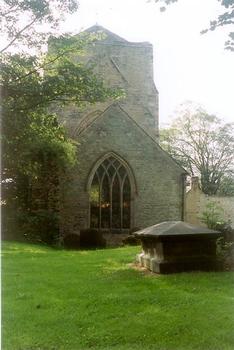General Information
| Status: | in use |
|---|
Project Type
| Function / usage: |
Church |
|---|
Location
| Location: |
Sheffield, South Yorkshire, Yorkshire and the Humber, England, United Kingdom |
|---|---|
| Coordinates: | 53° 19' 59.50" N 1° 30' 3.06" W |
Technical Information
There currently is no technical data available.
Excerpt from Wikipedia
Beauchief Abbey is a medieval monastic house now serving as a parish church in the southern suburbs of Sheffield, England. Beauchief is pronounced bee-chiff.
History
The abbey was founded by Robert FitzRanulph de Alfreton. Thomas Tanner, writing in 1695, stated that it was founded in 1183. However, Samuel Pegge in his History of Beauchief Abbey noted that Albinas, the abbot of Derby, who was one of the witnesses to the charter of foundation, died in 1176, placing foundation before that date. The abbey was dedicated to Saint Mary and Saint Thomas Becket, who had been canonised in 1172. Tanner stated that Robert FitzRanulf was one of the murderers of Thomas Becket and founded the abbey to expiate his guilt. Pegge also disputed this fact, showing that Robert FitzRanulf had no connection with the murder.
The abbey was of the Premonstratensian order founded by Saint Norbert at Prémontré in France. Members of the order are known as White Canons. Beauchief was a small house comprising around 12 to 15 canons plus lay brothers. It had the full range of monastic buildings including the abbey church, cloisters, chapter house, dormitory and refectory. A stream provided water to the Abbey and to fish ponds.
As with most monastic sites, Beauchief was an industrial as well as a religious centre. Farming on the Beauchief estate and on outlying manors was important, and the monastery also controlled iron smelting, mineral extraction, woodland industries and mills on the River Sheaf from which Sheffield takes its name.
The Abbey was dissolved in 1537 and the estate became the property of Sir Nicholas Strelley, from whom it descended to the Pegge family through the marriage of Edward Pegge of Ashbourne, Derbyshire to Gertrude Strelley, heiress of the Strelley's, in Norton on 17 July 1648. In 1671 Edward Pegge built Beauchief Hall using stone from the now ruined Abbey. In 1923 the estate was purchased by Mr Frank Crawshaw. Some of the land was sold for housing development but much was presented to Sheffield Corporation.
Beauchief Park today
Today only the western tower of the Abbey remains, together with some ruins (including a wall) to the immediate south-east. The tower is attached to a chapel (now a church) built in the 17th century, but what remains is a Scheduled Ancient Monument. The foundations of other buildings are visible and the medieval fishponds still exist. Much of the old estate is now occupied by two golf courses (Abbeydale Golf Club and Beauchief Golf Club), but several areas of ancient woodland remain: Parkbank Wood to the East of the Abbey, Old Park Wood and Little Wood Bank to the south, Gulleys Wood in the centre of the park and Ladies Spring Wood to the west. Public footpaths run through the estate, including across the golf courses and through several of the woods. The Sheffield Round Walk arrives from Park Bank Wood, running eastwards through Chancet Wood and on to Graves Park.
Text imported from Wikipedia article "Beauchief Abbey" and modified on July 23, 2019 according to the CC-BY-SA 4.0 International license.
Participants
Currently there is no information available about persons or companies having participated in this project.
Relevant Web Sites
- About this
data sheet - Structure-ID
20033558 - Published on:
04/12/2007 - Last updated on:
02/03/2020





